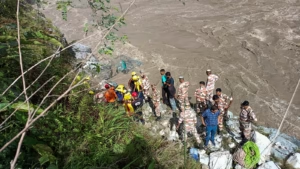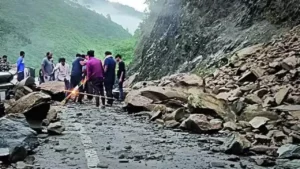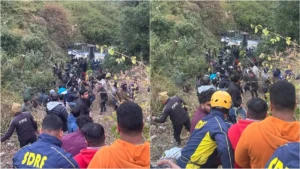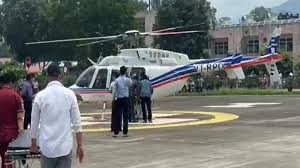Uttarakhand mishap: 2 dead, 9 missing as bus falls into Alaknanda river near Rudraprayag; more casualties feared, rescue operations on
Tragedy Strikes the Sacred Mountains: When Journey to Devotion Becomes a Fight for Survival

A view of the Alaknanda River as it goes over the mountains of the Rudraprayag at Uttarakhand. These holy waters are naturally beautiful and hardly portray the effect of the accident that rocked here on June 26, 2025, where the lives of many families were lost as a passenger bus fell into the river.
This is how every day and every morning of June 26th, 2025 started in the Himalayan state of Uttarakhand on the sinuous roads of the state. The pilgrims and the travelers would be on the road early in the morning with hopes of avoiding the afternoon heat in order to arrive safely at their destinations. To the 18 passengers of a passenger bus on the Badrinath Highway, on their way to Gholtir this morning it would turn out to be a nightmare beyond comparison, challenging human capabilities of endurance and group solidarity.
When The Mountains Called Their Own

The Badrinath Highway at Gholtir where the horrible accident happened. These are some narrow mountain roads which are wear buried in difficult terrains and are vital points of life lines to the local communities as well as pilgrims and require the utmost caution on the part of all travelers.
The Alaknanda River is the most sacred tributary of the river Ganges that has become the scene of horrible accident after a passenger bus of 18-seats capacity ran out of control and hurled in emergent waters of the river near the Rudraprayag district. The accident took place during the very early hours of the day, when still the mountain air is cool and the roads are not densely populated, so whilst the communities who have their own valleys with their own communities are small, the shock of the accident is just as devastating to them.
As early information suggests the bus was occupied by about 18-20 people when it lost its grip and skid off the track falling in Alaknanda river. The latest cause of the mishap is the current subject of investigation, but folks who have crossed the dangerous mountain highways know only too well how rapidly conditions can go a-gonzin the champaign country a loose stone, a little distraction on the part of the driver, or a technical breakdown, maybe the difference between safety on the one hand, and death on the other, along those single threads which wind along the perilous edges of the precipices.
Human Cost: Life and destroys Families
The recent news confirms that two individuals lost their lives in this disastrous accident and about ten people were missing. Behind these figures are tragedies of broken families, shattered dreams and societies that are already in sorrow because of their own. Every single missing person symbolizes something that cannot be replaced any more a mother that will never get back home, a father whose children wait in desperation, old pilgrims whose spiritual voyage ended in a tragedy.
Eight individuals are already saved out of the wreckage and the raging water and their rescue is the evidence of the divine will as well as human will. Taken out of the cruel grip of the river to which they are being dragged hand-in-hand with these physically injured people are the hidden wounds of having watched the body of fellow passengers swallowed up into the turbulent murky waters.
Three severely injured pilgrims are brought on air flights to AIIMS Rishikesh and all efforts are being made by medical fraternity to save lives which are in danger. View of helicopters flying creates a hope sign to families who have gathered at the riverbank searching the skies trying to see if their loved ones are among those who are being rescued.
The Unforgiving Geography of Faith
This tragedy is not only on the Badrinath Highway but a road, which doubles as a lifeline between remote communities in the mountains and a route travelled by religious devotees by the hundreds and thousands, all in the quest of spiritual fulfilment. This path is cut in one of the steepest and most difficult landscapes of India and to be respected by all visitors. Even the Alaknanda river runs parallel to most of this highway, the beauty of her nature camouflaging her deadly nature should anything go wrong.
These roads are well familiar to local residents. They have a sense of how unpredictable weather is, how what appears to be a safe stretch in the morning can turn extremely dangerous in the afternoon. The old folks of the village talk of the river in terms of awe and fear, it is the life giver of their valleys but it has taken away too many lives over the years.
The scene of accident, Gholtir, is exceptionally tough. The road is narrow and the downward vertical drops on one side and the tall cliffs on the other. These roads turn out to be far more dangerous in the approaching monsoons when the drivers and passengers have to face both loose rocks and sudden landslides.
Heroes in Uniform- The Race Against Time

SDRF workers and rescue teams of the locals are engaged in search efforts along the Alaknanda River. These courageous men and women did not give up and in an attempt to live their purpose dropped down treacherous cliffs and battled raging water in an attempt to save lives and give closure to their grieving families.
The State Disaster Response Force (SDRF), local police and district administration swung into action instantly to create a well-coordinated centre of life-saving measures at the scene of the accident. These fearless men and women who have seen so many tragedies of this nature tried to make their jobs professional with the emotional baggage attached of every human being that they had to save.
The SDRF rescue team that is specifically trained in mountain rescue and rescue in the waters, descended down the steep and loose cliffs and faced the raging torrent of the Alaknanda River. The orange was also the color of their uniforms that appeared as points of hope in the tragic view. Such rescuers, most of whom are locals too, are very familiar with the challenges of the terrain and employ it to overcome circumstances in which most rescue teams would have failed.
They went hand in hand with the specialized rescue teams although they were joined by local police officers, some of whom had been brought up in these valleys. They were very much aware of the geography of the area and their linkages with the locals, which turned out to be very useful when they were forming patterns of search and in coordination with such families who were trying to find news of their loved ones.
District administration agents made temporary command centers, organized logistics, arranged the collaboration with the hospitals, and made sure that they can maintain a connection with the state. Their contribution, less spectacular perhaps than the drama of the river rescues, was the main-spring of the whole work.
A Promise of a Chief Minister: A crisis leadership.

Chief Minister of Uttarakhand Pushkar Singh Dhami speaks on media over the bus tragedy. The fact that he was quick to act and ensure that all his available resources are utilized to carry out rescue missions portrays the interest of the state government in addressing the welfare of the citizens in times of crisis.
The Chief Minister Pushkar Singh Dhami also mourned deeply on the Bus accident that took place in Rudraprayag and added that rescue work was underway with available resources. His reaction is not only the official the duty but the personal relation that mountain-born heads have to their sorrows of the people.
Being a leader who knows the particulars of the rule in a land like the Himalayas, since Dhami is well aware of the mountainous nature inherent to the province of Uttarakhand, he has set the topic of road safety and disaster preparedness as one of the priorities of his government. Nevertheless, even preparation is not enough to completely do away with the dangers that accompany the mountain travel because even the geography turns into the enemy.
The quick reaction provided by the Chief Minister shows how the state government is keen on not leaving any stone unturned when it comes to rescue operations. He has been in close communication with rescue teams through his office to ensure that they are well equipped with all the resources that they need. This kind of attention by the top office gives some relief to the affected families that their tragedy could not be forgotten and downplayed.
The Community Response: How Neighbors get to be Family

Locals and other residents came to the place where the accident occurred and supported rescue services and families. The spirit of unity and compassion within the mountain communities is at full brightest when the mountain communities need it the most as neighbors become family to whoever needs the aid.
During the crisis, the real nature of mountain communities is revealed. Neighbors, who in many cases have never been acquaintance with the victims of the accident, are not afraid to participate in the rescue operations. They offered food, shelter, gave their boats and knowledge of the area and guarded together with the bereaved families.
On the highway there were tea stalls that served as a form of informal information center and people met and shared information about the news as well as trying to organize people as volunteers. The old women cooked food to those who were to be saved and old men, young men, took rescue workers to places in the river where there could be possibility of a victims being carried.
The local temples threw open their doors so there was not only physical accommodation in those times of loss and uncertainty but there was spiritual solace as well. Priests performed prayers to missing people and organized special ceremonies to dead people that allowed the community to accept the loss, feeling all the usual rituals and customs.
The Wider Picture: The Geographical Fight of the Uttarakhand State
This is the latest casualty in the history of the Uttarakhand road accidents which has been quite painful. The mountainous nature of the terrain in the state is also very beautiful yet momentous to transportation. Small streets, rugged terrain, unstable weather and an aging infrastructure are recipes that result in accidents that are disastrous in their effect.
Char Dham Yatra season adds to the burden of the transportation infrastructure of Uttarakhand as it can introduce hundreds of thousands of pilgrims into a sacred destination. Local traffic roads should have the capacity to move buses, cars and trucks bringing pilgrims across India. Together with the unawareness of drivers on the conditions of mountain driving, this means the prime cause of accidents.
The road condition and road safety has been a challenge with state authorities already investing a lot on it, however, it is still a huge challenge. Each mountain mile of road is worth millions of rupees construction cost, years of conscientious design. The metric used to measure growth does not only include kilometers of the road constructed but also the number of lives that are saved due to increased safety levels and emergency situations abilities.
The Psychological Effect: Wounds of the Soul
To those who survive such accidents, healing is long process that will not end with the restoring of physical health. The emotional trauma of seeing other passengers being carried away in swirling water, of helplessness as the bus was descending into the river leaves scars which might not be healed in the lifetime.
Mental health practitioners know that the survivors of mountain accidents usually have problems with survivor guilt, post-traumatic stress disorder and a lifetime dread of taking a mountain voyage. Others may never feel safe on the roads where they used to travel to visit family members and go to work and places of worship.
The psychological challenge may be considered the hardship of the unknown that the families of the missing endure. They are in a limbo they wait with hope and despair as it is without a closure with which they can conduct final rites. Others go on insisting that their loved ones may have survived and happened to be carried downstream, yet others start dealing with the awful process of accepting losses without the comfort of being in a position to lay their loved ones to rest.
The Economic ripple effect: Tragedy as a Livelihood Given
Such accidents have economic consequences more than just on the direct victims. News of accidents spreading is bad to the tourism industry which is the mainstay of the economy of Uttarakhand. Possible pilgrims and tourists cancel their trips, and this includes hotels, restaurants, guides, and a whole army of people whose lives directly depend on mountain tourism.
The local transport operators will be scrutinized more and possibly be subjected to new standards. There are safety issues that need to be addressed but the cost of complying with economic regulations can be too much when you consider the role of some small operators which maintain the connection to remote areas of many countries.
The family of the victims and the people of the community will struggle with insurance claims, legal actions and compensation talks months and even years on. The bus operator can be legally accountable, and the state government needs to implement safety conditions to the greater extent without dismissing the fact that it would be necessary to keep life in the mountains in its natural course.
Technology and Tradition: New Holes in Old Problems
In recent years technology has been tried to enhance mountain road safety. GPS tracking system, emergency communication equipment and the weather monitoring stations are the prospects of minimizing future tragedies. Nonetheless, the major problem with such systems would be the sheer scale of the terrain of Uttarakhand and its complexity.
Knowledge Tradition also has a significant contribution in mountain safety. Good motorists know how to sense when conditions are dangerous things like expectations in wind patterns, the sound of distant rockfall or the possible variation in the type of road surface that may be due to underlying difficulties. This is experience that has been around for generations by the mountain drivers, and sometimes this is more helpful than any technology.
It is about meeting these modern safety technology with ancient mountain knowledge and finding the way of making transport systems, which comply not only with the requirements of modern life, but also with the geographical peculiarities of mountains.
Search Still Goes On: Hope Against Hope

Helicopter rescue flying aerial surveillance over the Alaknanda river as search continues to find missing passengers. The vision of these planes flying around is one that has brought hope to families that have been looking along the bank of the river.
The search of the ten passengers is still going on in the Alaknanda River and the rescue teams are working tirelessly day and night under poor weather conditions. Every hour that messages about potential survivors remain unreported is that much less chance that any of them have a chance of survival, nevertheless, rescue teams do not give up, they believe in their duty to bring hope to suffering families.
The rescue has spread to the downstream where the water current may have brought victims and the teams are searching such points. The divers endure the cold, rough water and teams on land go looking along the riverbank. Aerial surveys are carried out by helicopters and their personnel scans the seas in search of the missing passengers.
Local boat-men have enlisted in the hunt and their familiarity with the river and its shoals and its perils has been most valuable. They are men of the water and because they live on the sea they know where the river yields its secrets and where it retains them in perpetuity.
Tutorials in Water and Stone
On any mountain accident a lesson is brought out and teaching by the lesson may help save future tragedies. This accident is bound to cause reviews to the bus routes being followed, training of bus drivers, bus safety standards and counter-measure processes. But the most valuable lessons are usually on the human end about how to act in a certain situation or how to make an effective decision and not on technical solutions.
The efforts taken by the rescue workers help remind us that we should never compromise having well trained emergency response teams. That is the power of neighbors helping neighbors in their time of need. This throws light on the usefulness of leadership that cares about the good of the people than political sides.
Citing Forth: Action as Honor:
With Uttarakhand grieving and reveling in the success of rescued people, the state has had to put again the old question of maintaining balance between access and safety in its mountains. The Badrinath Highway will not lose access to pilgrims and tourists, but this tragedy should not be covered by people forgetting about it since traffic on the road will settle down and headlines will die.
Whether this community can rise to the tragedy will only be fully evident in the months and the years to come. Will safety measures be introduced and preserved? Will there be greater preparedness in the event of emergency? Will it implement the lessons in training of drivers and emergency vehicle personnel?
Life will never be the same to the families of the victims. The place at the dinner table, the phone that will never ring with the voice familiar, the pilgrimage that did not bring the spiritual enlightenment and finished in the tragedy instead is what cannot be counted to the sum of money that will never pay for them.
River Remembers
Alaknanda River carries the memory of June 26, 2025 along its course and paths as it has been carrying through ages. This water which role in the wake of this tragedy, will finally get to the divine confluence of Devprayag, and after passing the ghats of Haridwar and Rishikesh where pilgrims pray for peace.
Here, water is depicted as destroyer and preserver as far as Hindu tradition teaches that each pint of water killed something and brought life in the same measure. The very river which took lives of people today, now gives water to millions of people, is the source of energy by hydroelectric plants or the way of spiritual purity. This dilemma, the role of curse and blessing of geographic position of Uttarakhand proves this life in the holy mountains.
As the rescue process goes underway and the families have resorted to their Lone Vigil, the society at large struggles with questions that do not lie easily. What is the balance between the human desire to connect and pilgrimage and the facts of dangerous terrain? What is the way to memorialise the dead and safeguard the living? So, on one hand, the landscape that constitutes our identity is the same one (or very close to) threatening our survival, how do we go into the future?
The solutions, just as the missing people, can be swept up in the stream of time and situation. All that is left is the human ability to show courage against the disaster, compassion during the tragedy and hope against all odds. These attributes are stronger than any technological or policy prescription that falls on mountain communities.
History is what will be recollected by the Alaknanda River in years to come, that is what it recollects everything about the pleasures and the misfortunes it has seen in the thousands of years. Those families whose lives were scarred by this tragedy will live to remember those losses, but they will also remember a populace that came out to do what it could to help, rescue workers who went into their burning buildings to save the lives of people they did not even know, and a leadership that felt the suffering of those people as their own.
In sacred geometry of Uttarakhand where each peak and valley has spiritual meaning then the story of this tragedy becomes part of the geography of the region- a lesson in the realization that the way to the divine can be on dicey ground but one does not have to seek that path alone.



